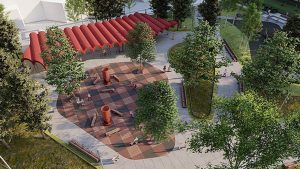A British company is trying to generate interest in a giant airship that could deliver building materials and equipment to construction projects in remote areas.
A British company is trying to generate interest in a giant airship that could deliver building materials and equipment to construction projects in remote areas.
The transportation of large components for oilsands construction projects near Fort McMurray is a perfect example.
It is difficult because reliable road access is an issue throughout much of the year.
In response to this challenge, Hybrid Air Vehicles is developing a new family of lighter-than-air vehicles known as SkyCat.
“Hybrid is Roger Munk’s innovation on the old technology, which is a combination of lighter than air technology, aerodynamic design and hovercraft technology for lift off and landing,” said Michelle Stirling of World SkyCat Western Canada Ltd.
“The traditional dirigible can’t take off and land on its own, but this vehicle can. The SkyCat can manoeuvre in a way that is similar to an aircraft and it can turn and bank in ways a dirigible can’t.”
Munk has sold airships to Japan, Australia, the U.S. Department of Defence and the U.K. Ministry of Defence.
Hybrid Air Vehicles manufactures lighter-than-air vehicles in Cardington, England and is hoping to find buyers in Canada.
One of its vehicles is a $100-million aircraft known as SkyCat 200.
This is the airship that could find its niche in Canada’s mega-project construction market.
“Our main target was the movement of oversized and overweight components that are hard to move in any part of the country,” said Stirling.
“We could take parts for large projects or portable camps, that are built in shops in the east or on the prairies, and deliver them with SkyCat. It eliminates the need to build roads and expensive infrastructure, which can’t be upgraded fast enough to meet the demand of oilsands projects.”
In late September, the idea was presented to some oilsands companies in Calgary.
“I would say half the people were very interested and half were skeptical,” said Stirling. “The skeptical people were asking, “If this is such a good idea, why hasn’t it been done yet?"
The SkyCat 200 has not been produced yet.
If a buyer is found, it would carry a payload of 200,000 kilograms, which is about 80 per cent more than a 747 freighter.
The cruise speed is 139 kilometres per hour and the range is 5,970 km.
“We are looking for a buyer or a group of buyers that state they need the service,” said Stirling.
“The intention is to bring the manufacturing to Canada. If we had someone write a cheque today, we could have a SkyCat 20 in about 24 months, the SkyCat 50 and SkyCat 200 would be about 36 months.”
The air cushion landing system allows the vehicle to land on flat land, grass, swamp, snow or on water, giving the vehicle fully amphibious capability.
The landing system is similar to a hovercraft and allows the airship to land without the normal lighter-than-air airship ground crew and ground landing infrastructure.
“The vehicles are 70 per cent more fuel efficient than anything out there. They solve the problem of remote locations and have a low environmental impact,” she said.
World SkyCat Western Canada is located in Ponoka, Alberta, which is not in the let down area of any major airports.











Recent Comments
comments for this post are closed